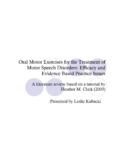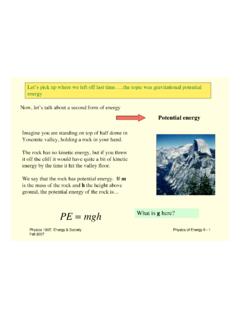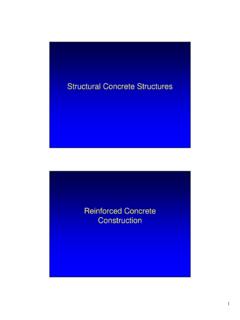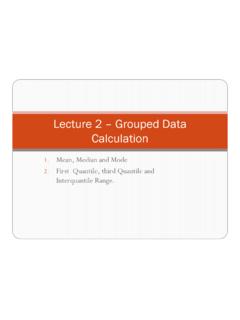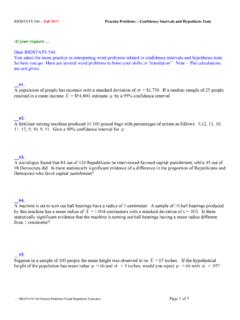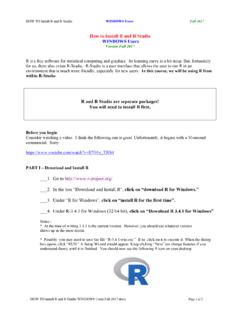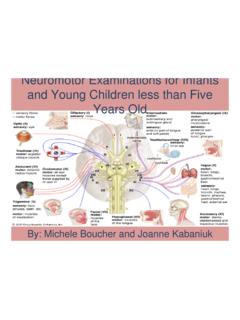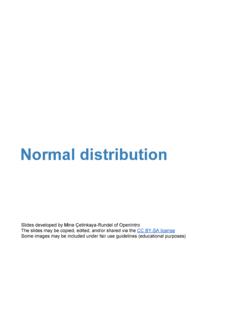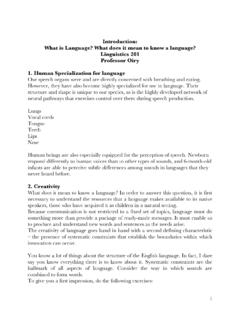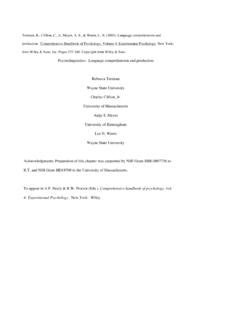Transcription of Voice Therapy for Neuropathological Voices - UMass …
1 Voice Therapy forNeuropathological VoicesMary V. Andrianopoulos, of Massachusetts-AmherstPhonation involves an interplay is an integration, perfect timing and coordination between intellectual + physiological processesCognition Languagesemantics + syntax + phonologyMotor Speech ProgrammerProgrammer + Plannerselection + sequencingArticulation shaping of soundsmotor speechmotor speech precisionResonation exhalationSupra-glottic + sub-glotticair flowshapes acoustic signal vianasal + vocal + oral cavitiesPhonation vibration of vocal foldsvoice + sound productionRespiration juice!sets air flow in motion +sets vocal folds into vibrationNeuropathological VoicesDysarthria = neuromotor speech/ Voice disorder Resonation Articulation Phonation RespirationDysphonia Dysarthria Non-neurologic Voice problem (vocal nodules, etc.)Dysarthrias with DysphoniasSpastic bilateral UMN Strained-strangled Hypernasality Regular, Slow rateHypokinetic BG circuits Monoloudness.
2 Monopitch Reduced volume (< drive) +/- Co-existing TremorHyperkinetic BG circuits Fast vs. slow movement Regular vs. irregular Phonation, RespirationFlaccid LMN (Cranial + cervical nerves) Nasal resonation Breathiness, hoarseness Reduced loudness DiplophoniaAtaxic Cerebellar circuits Incoordination, timing issues Irregular bursts, silent periodsDysarthrias also affect breathingDyspneumia: Neurologic effects RespirationHyperkineticRespiratory DystoniaOther Hyperkinetic DyspneumiasSuperimposed involuntary movementsAtaxicAtaxic dysneumiaIncoordination/timingRespiratio n PhonationSpasticSpastic DysneumiaRigidity, slownessCentral weaknessFlaccidFlaccid dysneumiaPeripheral weakness flaccidity MG, ALS,VF paralysisHypokineticHypokinetic Dysneumia volume, initiation/driveDuffy, 2005 Left HemisphereInferior Frontal LobeBasal gangliaCerebellumExtra-Pyramidal tractPyramidal TractCranial + Spinal Motor NervesPropathic + Epicritic Cranial Sensory NervesNeural Networks for Voice and SpeechThe Final Common Pathway of Speech and VoiceA system of tubes + valvesWith Sensory + Motor networkssoft palatevocal foldsUESnaresAdapted from Carrau, 2006 Therapeutic Pre-requisites1) Differential Diagnosis Multidisciplinary team approach Medical assessments (ENT, Neurology, etc.
3 Voice assessment (ENT, SLP-Vocologist)2) Scope of Practice Preferred Practice Patterns3) Amass Baseline Data Pre-Tx, Per-session, Post-Tx, Follow-upRegarding Tx for Neuropathological VoicesWhat are the beneficial effects of Tx?What level of evidence is available?Consider + Contribute to: Evidence Based Medicine (EBM) Evidence Based Practices (EBP)Empirical Studies Reviewedfor EBP + levels of EvidenceTotal # published studiesN = 55 (1996-2007)~ 50 eliminatedBreakdown of Behavioral Biofeedback Instrumentation TXReasons for eliminationNo SLP TX administeredMedical- Surgical TX, Hypnosis, Acupuncture, Chiropractic, , Whitmal, & Astin, 2007 Group Design(Andrianopoulos, Whitmal, & Astin, 2007)CriterionResponse%Number studiesInclusion 67%33 Inclusionexclusion33%16No90%44No71%35 Yes29%14 Yes10%15 BlindingRandomizationSubject selection criteriaConclusions(Andrianopoulos, Whitmal & Astin, 2007We found that: Prospective studies: 95% (52/55) Retrospective studies.
4 4% (2/55) 94% of studies reported change 2 TX Pre-TX Post-TX studies ( ) 62% of the studies were type Ib + IIa 71% reported statistical significance, yet 12% reported Effect size 6% reported Confidence Intervals 29% reported Reliability,0% ValidityEffectSize% Subjects in Control group below aver subject in treated of guessing group membership from a single effects on acoustic parameters in dysphonic subjectsSpeyer, 2003 MacKenzie, 2001 Speyer, 2004 DeJonckere, 2003 Mashima, 2003 Roy, sizeEffect Size 0 1 2 Treatment Effects Acoustic Changes in Dysphonic PatientsEffects of Voice Therapy on self-rating scales for dysphonic sizeRoy 2003 MacKenzie 2001 Roy 2002 Roy 2001 Ave r a g eEffects of Voice Tx using Rating Scales of Dysphonic PatientsEffect size 0 a study demonstrates statistical significance, it does not demonstrate practical significanceunless it determines its Effect Size (ES).
5 So, a study can have statistical significance and may not be practically ES size of has an overlap of 45%.The smaller the ES, the more overlap, the less difference between groups as a result of Principles Many patients with neuromuscular problemsaffecting phonation develop bad habits (valves + tubes) Many of these habits do not always go awayonce you repair lost function.(Wan-Fu Su; Yu-Che Hsiao; Chung-Ching Hung, 2007)General Treatment PrinciplesObjective: To Improve effectiveness, efficiency and naturalness of phonation for its intended purpose Restore lost function , ENT surgery for VF paralysis, etc. Compensate, pleasant as possible Adjust with least effort as possibleNeuropathologies with HypophoniaIncrease volume louderGreater prosodic rangeExamples: LSVT (Ramig et al.) Parkinson s Disease Aging Effects: Presbylaryngeus Ataxia VF paralysis, Cerebral Palsy, Downs SwallowingNeuropathologies with HyperphoniaStrained, harsh, tight Relaxation, alter pitch + intonation, stretch, flow, laryngeal massageExamples: Spastic Dysarthria RigidityVagus Nerve Lesions Pharyngeal nerve Soft palate Hypernasality Prosthetic Devises LMN weakness Possible for UMN weakness ?
6 ResultsSpasmodic Dysphonia SD abnormal involuntary movements: are action induced and task specific Movement during vocalization: Involuntary co-contraction of muscles used to produce sound. Yet, patient has normal structurePatient Complaints, Other Symptoms Spastic Dysarthria Speech is slower, it tires me My speech is nasal Swallowing difficulty Drooling Difficult to control laughter or crying (pseudobulbar affect) Pathologic reflexes Weakness Spasmodic Dysphonia Negative impact on job, social life, and emotions Vocal fatigue caused by increased effort in speech Body motions or tenseness may be present secondary to spasms (AD type) Frustration getting accurate DXDifferential DiagnosisADSD vs. MTDC urrently there are no definitive diagnostic criteria used to differentiate between these two very different Voice disorders! But, we are getting better:(Andrianopoulos, 2008; Duffy, 2005; Roy, 2001)Differential Dx: MTD vs.
7 ADSD Phonatory air flow (Higgins et al., 1999) ADSD vs. MTD vs. Normals ADSD > Phonatory airflow + Air Flow Perturbation Task specific phonation (Roy et al., 2005; 2007) During speech + sustained vowel [ah] Spastic Dysarthria continuous speech, vowels ADSDs > severity connected speech vs. vowels MTD no difference, speech vs. vowelsCompensationUse of residual function Modifications in rate + prosody Prosthetic devices to amplify Voice /speech Reduce nasal airflow (palatal lift, CPAP) Pace rate of speech to increase precision Alternative means of communication Modify physical environmentFactors that Influence Voice Treatment Stability of medical and neurological conditionFactors that Influence Voice Treatment Do you defer Voice treatment after surgery or the therapeutic effects of medications?Factors that Influence Voice TreatmentPD; ALS, MS, other neuropathologies For degenerative cases, Stepwise management counseling Maintain intelligibility Counsel patients Prepare for AAC Quality of LifeIndividual considerations Major + Minor Voice impairments have Major + Minor effects on the patientFocus of treatment Work on systems or components: From which the greatest benefit will be derived rapidly that will provide the greatest support for Voice improvement More Bang for your Buck!
8 ! For example: improve respiration to improve loudness, Voice + intelligibility Lee Silverman Voice Treatment (LSVT PD)Management Approaches Prosthetic Voice amplifiers Palatal lift prosthesis/bite blocks Pacing tools: metronomes, DAF, biofeedback Augmentative + Alternative Communication Behavioral ManagementGoal is to maximize communication Speaker-oriented: improve Voice , resonation, intelligibility reduce impairment Communication-oriented: environmental manipulationsUse Principles of Motor Learning It is a process of acquiring the capability for producing skilled actions (Schmidt, 1988; 1998, 2000) (Clark, 2005; Duffy 2005, Robbins, 2007; Seminars in SLP, Nov. 2008) Sensori-Motor (vocal) learning is a result of: Experience: Proprioceptive learned Practice (systematic, frequent, shorter sessions) Feedback ChangeConditions of Practice1. Prepractice Vocal Warm-up exercises2.
9 Repetitive practice3. Mass vs. distributed practice4. Low force high velocity5. Recovery periodmuscle overload strength power endurancePractice Consistent: repetitions on a single task reduce the df increases immediate learning of skill facilitates speed + automaticity of response Variable practice: range of related activities that target same objective and muscle groups better retention + generalization Systematic routines + practiceMore on Feedback Instrumental feedback: Biofeedback, Visual Feedback-strobe, EMG Mirror, VU meter Quantity and quality of feedback Knowledge of Results Knowledge of Performance Journal, data, regression/improvementSpecificity of Training Important to match the contractioncharacteristics of the exercise to the desired movement outcome. You treat Voice with Voice specifically for Communication Singing Work with functional groups of musclesas treatment targetsAre non-verbal oral motor speech and exercises beneficial for speech?
10 ? For swallowing, there is evidence (some) For speech/ Voice , controversal for Neuropathological dysarthrias + dysphonias Seminars in SLP (November 1988)Hypotonia: Increasing Strength Overloading muscle increase strength Low-resistance, high-repetition exercises** Voice High-resistance, low-repetition exercises (swallowing) Isotonic exercises vs. Isometric exercises Isometric muscle stays the same length, but changes tension (Relaxation, massage) Isotonic muscle changes length, maintains the same tension (using Voice with less effort, no MTD, good PTP Resonant Voice TX) Voice Therapy Approaches Direct Patient Oriented improve Voice , resonation, intelligibility Increase loudness LSVT-Ramig et al Expiratiory Muscle Strengthening (Sapienza, Murdoch, etc.) Indirect Adjustments + Education Use amplificationBehavioral Treatment: Flaccid DysarthriaUnilateral Vocal Fold involvementObjective: To improve vocal fold adduction and vibration without strain and muscle tension Inhalation Phonation Head turning to left or right (Casper + Colton) Lateral digital manipulation Vocal Function Exercises Glottal Gap Reduction Techniques (MTD)Treatment: Flaccid DysarthriaSoft palate weaknessObjective: To reduce nasal resonance for speech purposes Velopharynx: Sensory, mechanical or electrical stimulation (?)
